
【英日対訳】「大戦時の日本軍による性的奴隷化を証明した文書 訳者の母校の蔵書に加わる」LJ-World(2016.1.17)完全版
[Last Updated: 2020.10.11]
はじめに
以下は、2016年1月17日に米ミズーリ州カンザス市のローカル紙が報じた内容を著者の公式アカウントからキャッチし、著者の許諾を得て翻訳した内容です。同20日には要約を完了し同26日には全訳を完了していたのですが、当時はnoteのようなものがなくて、evernoteというWebクリップアプリで直接記事を翻訳していました。昨今、「あいちトリエンナーレ2019」での『表現の不自由・その後』展での展示内容の中で、『平和の少女』像といわれる、いわゆる「慰安婦像」と一般に捉えられる展示について批判や脅迫が殺到し、「展示中止」となってしまったことを受け、「終わりのない戦後」に終止符を打つべく、終戦74年にあらためて平和を祈念して再掲するものです。

翻訳は、後述するTogetterやTwitter Momentにもまとめてあります。本note上とTogetterのみに記載される小見出しは、記事の区切り上、訳者である私が内容を勘案して適宜付け足したものです。また画像資料やURLリンク等も記事の掲載内容から追加しています。他のまとめ(ドラフト版)とは異なりこのnoteが完全版となります。ご了承ください。
大戦時の日本軍による性的奴隷化を証明した文書
訳者の母校の蔵書に加わる
Document proving WWII military sex slaves now at home in KU library
慰安婦問題に関する日本政府の謝罪を導き出したと称される、長年カンザス大学の教授を務めた人物により翻訳され保管された文書『調査報告第120号』(’Research Report No. 120’)
Translated and saved by longtime KU professor, ‘Research Report No. 120’ credited with prompting Japan’s apology to 'comfort women'

サラ・シェパード(Sara Shepherd)著
2016年1月17日
米国ミズーリ州カンザス大学で歴史学の教授を長く務めたグラント・グッドマン(Grant Goodman)氏は、多くの文書を個人で所有していた。
Grant Goodman, a longtime Kansas University history professor, naturally had many personal papers.
現在、カンザス大のスペンサー研究図書館(Spencer Research Library) には、9フィート(約2.7メートル)もの高さに及ぶ文書類が、幾つもの箱に分類されて、保管されている。
2014年にグッドマン氏が亡くなった後、収集されたものだ。
KU’s Spencer Research Library now houses 9 linear feet of them, divided among numerous boxes, gathered from Goodman’s home after his death in 2014.
最近、この研究図書館の蔵書に、とりわけ機密に類する文書が加わった。それは、グッドマン氏の貸金庫から見つかったもので、『Research Report No. 120: Amenities in the Japanese Armed Forces(調査報告第120号「日本軍隊における生活利便施設」)と題された文書だった。
But one particularly sensitive document was added to the library’s collection later, after being retrieved from Goodman’s safety deposit box: “Research Report No. 120: Amenities in the Japanese Armed Forces.”
この1945年の報告書は、第二次世界大戦当時、日本がアジア全域に渡って、軍兵の娯楽のため官営の慰安所を保有していたこと、そしてその一部には奴隷化(enslaved)された「いわゆる慰安婦」(”comfort girls”)」たちがいたことを証明するものだった。
The 1945 report proves Japan had government-controlled brothels — some featuring enslaved “comfort girls” from across Asia — specifically for its military men’s pleasure during World War II.
グッドマン氏は二十歳のころ、当時陸軍少尉として所属した陸軍情報部でこの文書の翻訳に携わった。そして彼がその十数年後に行ったある行為が、1993年、今日「慰安婦(”comfort women”)」といわれている元売春婦たちに対する日本政府の公式謝罪へと繋がったといわれている。
Goodman himself translated it as a 20-year-old second lieutenant in the Army’s Military Intelligence Service, and what he did with the document decades later is credited with contributing to Japan’s 1993 formal apology to former prostitutes now known as “comfort women.”
つい先月、日本政府は残る数少ない80~90代の元性奴隷たち(sex slaves)を支援する基金に830万ドルを拠出することを約束した。
Just last month, Japan for the first time pledged government money — $8.3 million — to a foundation supporting the few remaining sex slaves from Korea, now in their 80s and 90s.
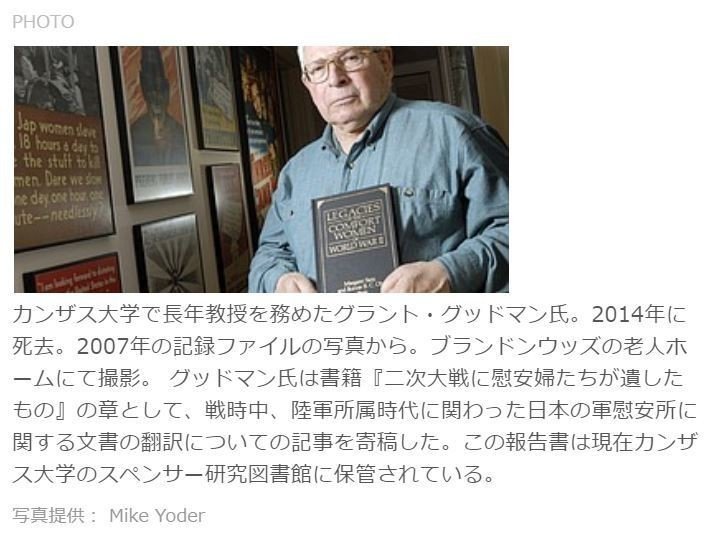
グッドマン氏はのちに、『報告書第120号』を翻訳した経験を「My Own Gaiatsu: A Document from 1945 Provides Proof」(「私自身によるガイアツ 証拠となる1945年の文書」)と題された記事として掲載され、そののち2001年に書籍『Legacies of the Comfort Women of World War II』(「第二次世界大戦の『慰安婦』という負の遺産」)に転載された。
Goodman wrote of translating the document and eventually sharing it with the world in the article, “My Own Gaiatsu: A Document from 1945 Provides Proof,” which was printed in the 2001 book, “Legacies of the Comfort Women of World War II.”
その記事で、グッドマン氏はこう語っている。
「いわゆる「慰安婦」に対する責任を日本の首相に認めさせることに、私自身が暴露(revelation)したATIS(連合軍総司令部翻訳通訳課)の『調査報告第120号』が重要な役割(critical role_)を果たしたことについては勿論、私は誇りに思っている。ただ──」
“I am, of course, proud of the crucial role that my own ‘Revelation’ of the contents of ATIS (Allied Translator and Interpreter Section) Research Report No. 120 played in bringing about the Japanese prime minister’s acceptance of responsibility for the so-called ‘comfort women,'”
グッドマン氏はこう続けた。
「これまで他の多くの類似した状況でも見られたように、日本政府が、外国人に議論の余地のない(incontrovertible)証拠を突きつけられて初めて、事実を認め、悔恨の意を表明するというのは、じつに痛ましいこと(truly tragic)である」
Goodman wrote. “However, as in so many analogous instances, that the Japanese government only made its admission and evidenced contrition after a foreigner provided incontrovertible evidence is truly tragic.”
極秘報告書作成の経緯と内容
同氏の訃報によれば、グッドマン氏は幼少の頃、クリーヴランドに暮らしていたときにアジアに興味を持ち、世界中のスタンプを集め、貪欲なまでに本を読み漁ったという。
Goodman’s interest in Asia started as a child in Cleveland, where he collected stamps from all over the world and read voraciously, according to his obituary.
高校を卒業してプリンストン大学に入学すると、グッドマン氏は本格的にアジア研究に取り組むようになる。
After high school graduation, he was eager to formally pursue Asian Studies and started college at Princeton University.
自著 『My Own Gaiatsu』によれば、1943年、グッドマン氏は18歳でMilitary Intelligence Service Japanese Language Officers(陸軍情報部日本語担当官特殊育成プログラム)に入隊を認められ、1945年には、フィリピンにあるダグラス・マッカーサー元帥率いる連合国軍総司令部(SCAP)に配属された。
In 1943, at 18, Goodman enlisted in the Army after being accepted into a special training program for Military Intelligence Service Japanese Language Officers, according to “My Own Gaiatsu.” By spring 1945 he was in Manila, the Philippines, assigned to the headquarters of U.S. Gen. Douglas MacArthur.
数あるグッドマン氏の任務のひとつが、日本軍の士気要因に関する情報の収集と翻訳だった。その要因のひとつと見られたのが、brothels(慰安所)だった。
Goodman’s job was gathering and translating intelligence on, among other things, the morale of the Japanese military.
One contributing factor was their brothels.
運動施設や映画、娯楽所などに加え、グッドマン氏が発見したのは、慰安所に関する詳細な記述だった。その書類の束が、カンザス大学のスペンサー研究図書館に保管されている。
"RESTRICTED"(極秘)と打たれたその書類の表紙には、こう書かれていた。
Along with information about athletics, movies and canteen stores, what he learned about the brothels is outlined in detail in a bound document now archived at KU’s Spencer Research Library. Labeled “RESTRICTED,” the booklet is titled:

Supreme Commander for the Allied Powers
連合国軍総司令部
Allied Translator and Interpreter Section
連合国軍翻訳通訳課作成
Research Report
No. 120
調査報告
第120号
Date. 15 Nov 45
日付 1945年11月15日
AMENITIES IN THE JAPANESE ARMED FORCES
日本国軍隊における生活利便施設
この報告書によると、日本軍の中佐が作成したマニラにおける慰安所運営規則や規定が含まれる小冊子には、 "houses of relaxation"(慰安所)はstrictly for soldiers and army civilian employees(兵士や陸軍の軍属のみに厳に限定して使用を認められていた)ことが明記されていた。
According to the report, a booklet outlining rules and regulations for brothels in Manila, issued by a Japanese lieutenant colonel, made clear that such “houses of relaxation” were strictly for soldiers and army civilian employees.
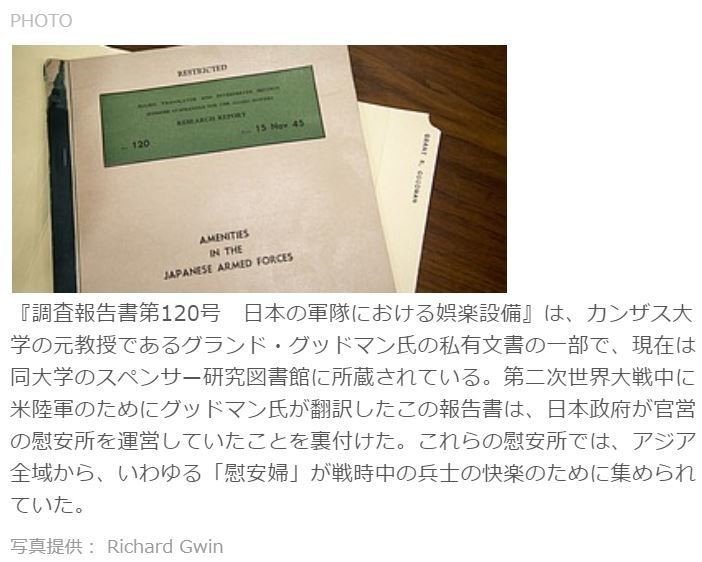
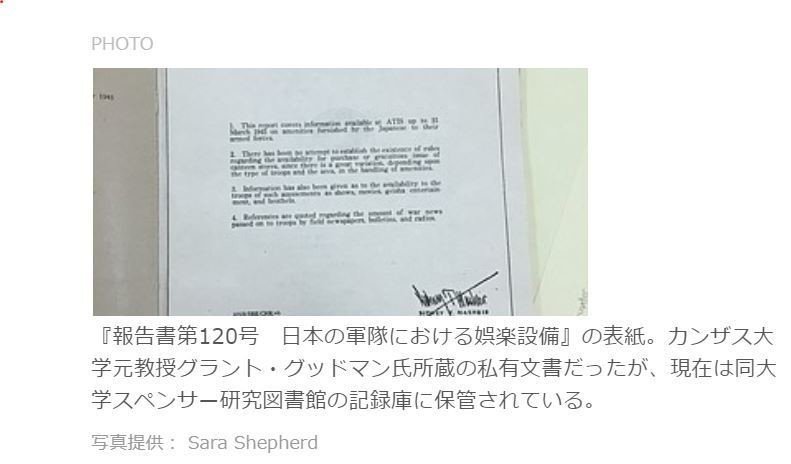

新規に従業員(employees)を雇用するにも価格を設定するにも、すべて軍の許可が必要とされ、売春婦ら(prostitutes)は許可なく施設の外に出ることを禁じられた。
Permission from the army was required for everything from hiring new employees to setting prices, and prostitutes were forbidden to leave without army permission.
従業員は、月1回の休みを認められ、ある唯一の例外を除いて経費はすべて自己負担しなければならなかった。
Employees got one holiday a month and had to pay their own expenses with one exception:
「過労に起因する疾病の治療費については、その七〇パーセントを経営者(managers)が、三〇パーセントを接客婦(hostess)が支払うものとする。個々の疾病が過労に起因するものであるか否かの判断は、軍医の診断にを基準とする。」(※訳書『従軍慰安婦資料集』記載の内容と差し替え)
“Medical expenses for illnesses arising from overwork will be met seventy percent by the managers and thirty percent by the hostesses. The diagnosis of an army physician will be the basis for determining whether any particular illness is due to overwork.”
衛生に関する規則は広範に渡った。
接客婦は、週一回、性病及びその他疾病について軍医の検査を受けることを義務付けられ、疾病中に顧客に奉仕(“entertain”)することを禁じられた。
Rules on hygiene were extensive.
Hostesses were required to be examined by an army physician once a week for venereal diseases and other illnesses, and forbidden from “entertaining” guests while sick.
『調査報告第120号』にも、類似の規則のほか、日本が支配するフィリピン、上海、パプア・ニューギニア、ビルマ [現在のミャンマー] 、インドネシアに設置された軍慰安所についての情報も記載されていた。
Research Report No. 120 includes similar rules and other information about military brothels in Japan-occupied areas of the Philippines, Shanghai, Papua New Guinea, Burma and Indonesia.
また、料金表(朝鮮人売春婦の方が『中国人売春婦より割高で、日本人売春婦の方が朝鮮人売春婦より割高だった)や、医療検査のための申請書や運営手続きに関わる書類等も記載されていた。
There also are rate charts — indicating Korean prostitutes were more expensive than Chinese, and Japanese were more expensive than Korean — and various required forms for medical examinations and business operations.

ビルマ(現ミャンマー)で軍慰安所を経営した戦争捕虜 [※訳注: この場合は連合軍が拘束した日本軍兵士を指すものと思われる→のちに軍慰安所を経営する日本人の実業家であったと訳書『従軍慰安婦資料集』で確認。] の証言によると、この男性は妻と共同で22名の朝鮮人 [未婚女性] をその家族から買い受けたという。支払額は性格、容貌、年齢に応じて設定された。陸軍当局は、これら"comfort girls"(慰安婦)の通行費と医療費を負担した。
A prisoner of war who had operated a military brothel in Burma said in the report that he and his wife purchased 22 Korean women from their families, with prices based on their looks, personalities and ages. Army authorities paid for the passage and medical treatment of the “comfort girls.”
「慰安婦は、彼女の家族に前貸しされたお金と、それに加えて利息を返済できた場合には、朝鮮へ帰るための無料の交通の便宜を提供され、あとは自由の身であるとみなされることになっていた。」
ただし、報告書によると、「戦況のゆえに、これまでのところ、M七三九のグループではだれ一人として、帰国を認められた者はいなかった。」
(※引用は全て訳書『従軍慰安婦資料集』の記述と差し替え)
“When a girl is able to repay the sum of money paid to her family, plus interest, she should be provided with a free return passage to Korea, and then considered free,” according to the report. “But owing to war conditions, no one of prisoner of war’s group had so far been allowed to leave.”
極秘報告書公表の経緯
翻訳した当時は、この資料はとくに関心を呼ばなかった。なぜなら、米軍は日本が軍のために慰安所を運営していたことを「十分に承知していた("knew well")からだ」と、グッドマン氏は自著『My Own Gaiatsu(私自身によるガイアツ)』に綴る。
At the time he translated it, the material didn’t arouse any special interest since the U.S. military “knew well” the Japanese were operating brothels for their armed forces, Goodman wrote in “My Own Gaiatsu.”
「しかし個人的な感覚でいえば、まだ二十歳という多感な年代で、オハイオの中流階級出身の無垢な青年だった私からすれば、これらのデータはひじょうに情報に富むものだった。だからこそ、GHQで報告書が配布のため正式に発行されたとき、私はそのコピーを保管して自宅に郵送しておいたのだ。両親には、私が帰宅するまで保管しておいてほしいとお願いしておいた」
“Speaking personally, however, at the then tender age of 20 and being a very innocent youth from a middle-class American family in Ohio, I found these data very informative,” he wrote. “Accordingly, after our report was published for circulation at GHQ, I managed to keep a copy and mailed it home with a request that my parents keep it for me until my return from overseas.
グッドマン氏は1992年にAP通信のある記事を読むまで、資料を掘り出そうとはしなかった。記事には、ヨシミヨシアキ(吉見義明)氏という日本の大学教授が[旧]防衛庁の記録の中から、日本政府が大戦中の慰安所の運営に直接関与していることを示す書類を発見したことが取り上げられていた。
Goodman didn’t dig it out again until 1992, when he read an Associated Press story about a Japanese university professor named Yoshimi Yoshiaki who’d found documents in Defense Agency archives showing the Japanese government’s direct involvement in the WWII brothels.
ところが、日本政府は吉見氏が発見した書類の信憑性を疑った。グッドマン氏はこのことに驚いた。グッドマン氏を含めアメリカ側は誰もが慰安所やイアンフ(”ianfu”)のことを半世紀近く知っていたからだ。
そして彼の手元には、『報告書120号』のコピーがあった。
However, Goodman wrote, the Japanese government questioned the authenticity of Yoshimi’s documents.
Goodman found this surprising.
After all, he and other Americans had known about the brothels and comfort women, or ianfu in Japanese, nearly 50 years, and he still had his copy of Research Report No. 120.
「その内容はきわめて緻密で、日本政府がイアンフの慰安所[の運営]に関与していたことを疑う余地はなかった。問題は、私が次に何をすべきかということに移っていた」
“Its contents were extremely specific and left no doubt of Japanese government responsibility for the ianfu brothels,” he said. “The question became what my next move should be.”
スクープを掴んだ共同と報じた読売
グッドマン氏は『報告第120号』をある日本人のジャーナリストに速達で郵送した。このジャーナリストは別件で一度彼を取材したことがあった人物で、事実確認のため再び電話してきて、引用を逐一チェックするような人だったと、グッドマン氏は振り返る。
Goodman FedEx’ed a copy of Research Report No. 120 to a Japanese journalist — one who’d interviewed him previously on another subject and called back to fact-check and verify quotes, Goodman wrote.
こうして、共同通信社ワシントン支局に勤めるミウラ・ジュンジ(三浦準司)氏は、生涯のスクープを手に入れる。
Miura Junji of the Kyodo News agency’s Washington Bureau ended up with the scoop of his career.
1992年2月、『報告』の内容が主要各紙やTV番組のほぼすべての紙面を埋め尽くした。
In February 1992, a story on the report’s contents broke on the front page of nearly every Japanese newspaper and TV news program.
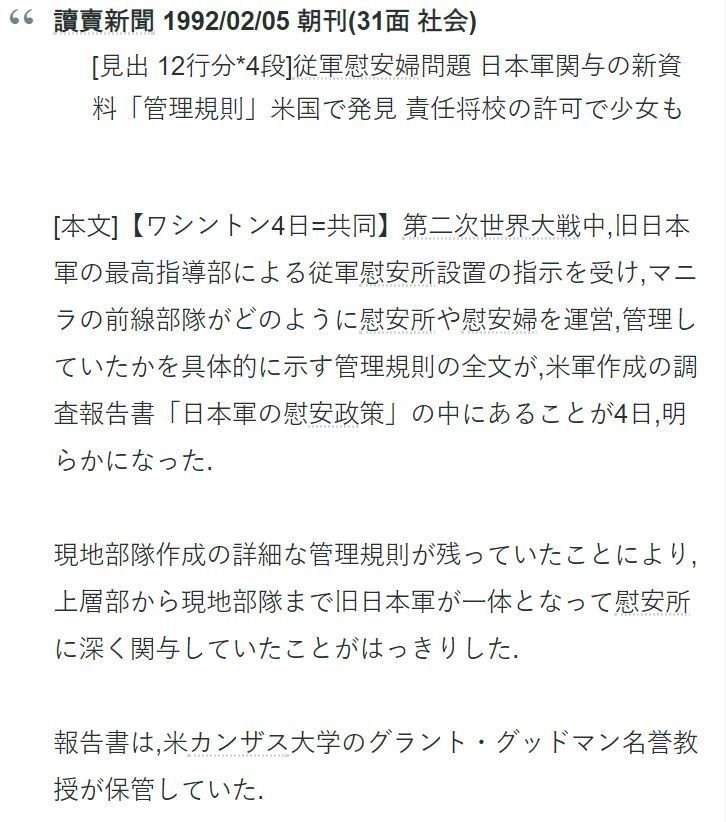
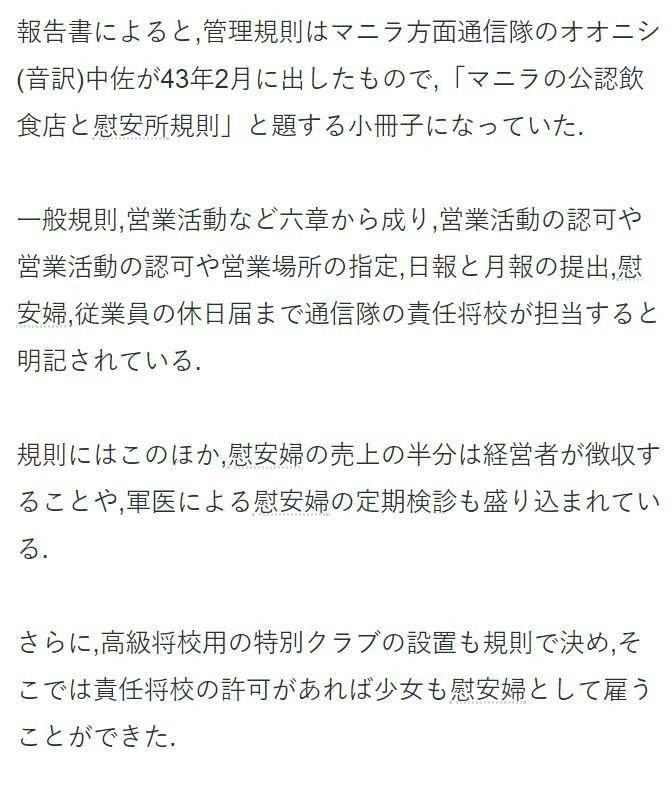

カンザス大学に保管されている英訳の記録によると、記事には次のように書かれていた。(逆翻訳)
「報告書は、旧日本軍がアジアの旧支配地域において、問題となっている慰安所の運営と幇助(abetted)を行ったことを示すもっとも仔細な記録となる可能性がある。旧日本軍の文書の翻訳を担当し、現在はカンザス大学で日本史を研究するグラント・グッドマン教授により共同通信に提供された」
“The report, made available to Kyodo News Service by Professor Grant Goodman, a former translator of Imperial Japanese Army documents and now a Japanese scholar at the University of Kansas, provides the most detailed account yet on the controversial brothel operation run and abetted by the Japanese military in occupied Asian territories,” the story said, according to an English translation on file at KU.
マスコミ各社の報道についてグッドマン氏は、友人や見知らぬ人から感謝の意を示す手紙や電話を受け取ったという。またカンザス市の日本総領事からも電話があり、グッドマン氏は弁護士と相談したのち、総領事の担当者との会談に応じ、『報告書』のコピーを渡すことに同意したこともあった。
In response to the media reports, Goodman said he received appreciative calls and letters from friends and strangers alike. He also received a call from the consulate general of Japan in Kansas City and, after consulting with his attorney, agreed to meet a consulate representative and provide him a copy of the document, too.
日本政府に対する憤り
グッドマン氏は共著でこう振り返る。
「その後生じた国内外の圧力により、日本政府は遂に、性的労働者(sex worker)が日本軍に奉仕するために徴用(forceful recruitment)されたことを認めるに至った」
1993年8月、日本政府はこの責任を認め謝罪する公式声明[いわゆる河野談話]を発表した。
Subsequent national and international pressure mounted on the Japanese government to admit its forceful recruitment of sex workers to service the Japanese military, Goodman wrote. In August 1993, the Japanese government issued a public admission and formal apology.
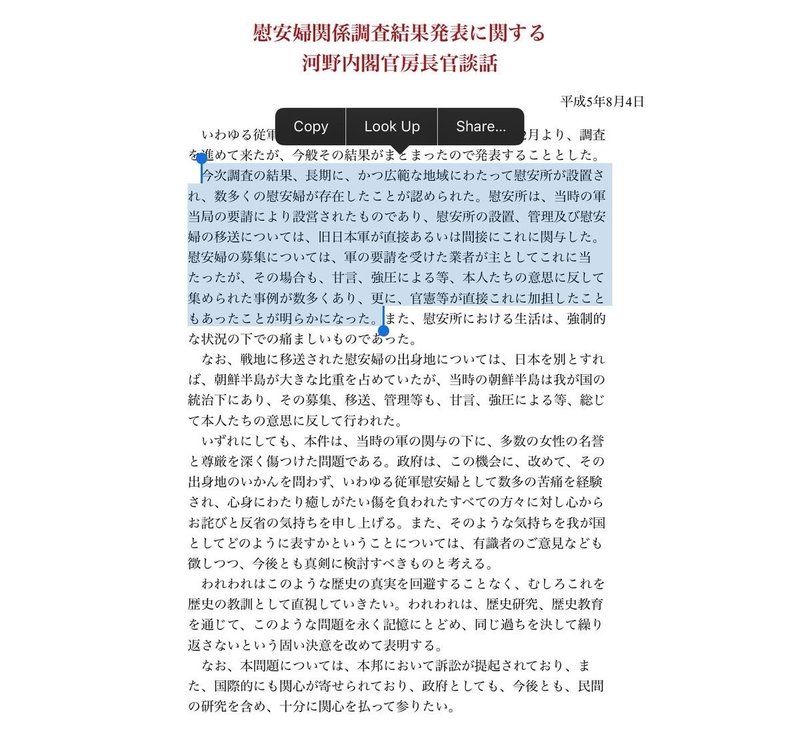
歴史家らによれば、旧日本軍の慰安所で働いてた慰安婦は数十万人を下らないという。
Historians say there were at least tens of thousands of Asian comfort women working in the Japanese military brothels.
昨年12月に発表された慰安婦問題の決着は、多くの慰安婦が関わった韓国と日本のこう着状態を打開する画期的合意だったといわれている。
The new comfort women settlement, announced in late December, has been called a landmark in the decades-long impasse on the issue between Japan and South Korea, where many women came from.
しかしこの日韓合意に関するニューヨークタイムズ紙の記事によれば、昨年末まで、日本の安倍首相とその取り巻きは右派勢力の圧力を受け、この表明の証拠となった文献を見直すことを約束していた。
However, as recently as last year, Japanese Prime Minister Shinzo Abe and his allies — pressured by the right wing to scrap the 1993 apology — agreed to again review the evidence that led to it, according to a New York Times article on the settlement.
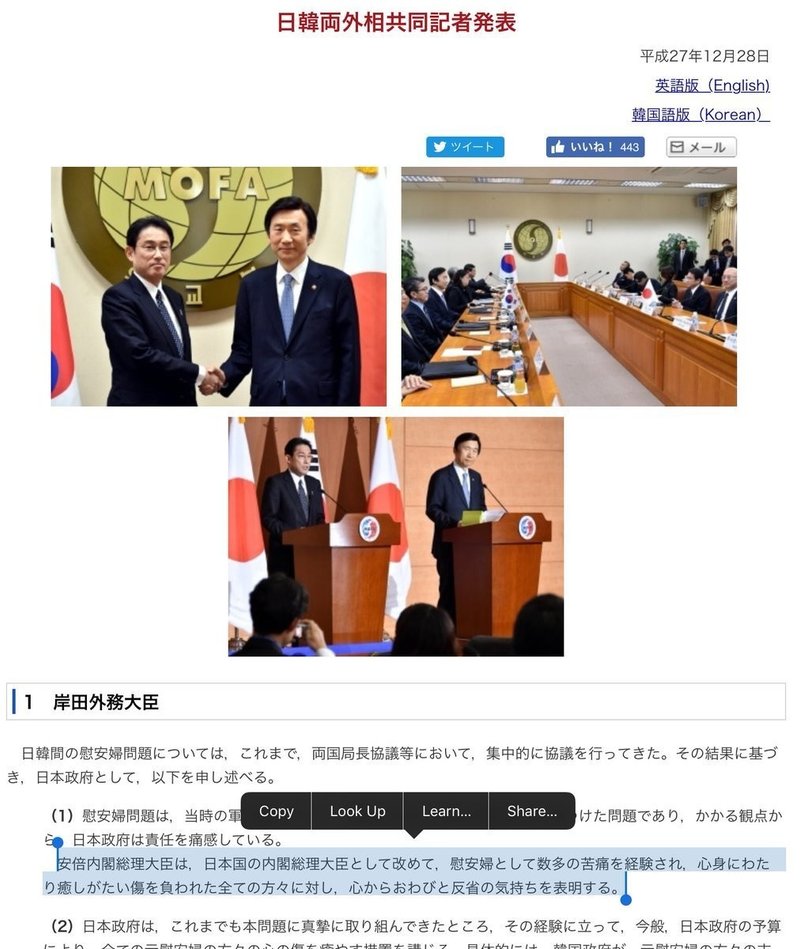
また2007年、当時の安倍首相は日本が慰安所で女性らを強制的に働かせた(coerced women to work in the brothels) 証拠はないと公然と否定した。その後、本紙Journal-Worldはグッドマン氏にたいしこの件に関する感想を取材していた。
In 2007 Abe also publicly denied there was evidence to indicate Japan coerced women to work in the brothels, after which the Journal-World interviewed Goodman for his reaction.
「信じ難いことだった。こんなばかなことがあるだろうか?なぜ今?何年もの間、この件は語られてすらこなかったのに?」
グッドマン氏はこう答えた。
“I was disbelieving,” Goodman told the newspaper. “I thought, ‘This is cuckoo, why now? This issue has been buried for years.'”
グッドマン氏の闘い
「"ガイアツ"とは、"外部からの圧力"を意味する」
共著『My Own Gaiatsu』でグッドマン氏は、慰安婦問題の謝罪を得るための努力してきたことについてこう嘆いた。
“Gaiatsu” means “foreign pressure.”
In his article “My Own Gaiatsu,” Goodman bemoans that’s apparently what it took to spur the comfort women apology
「なぜ私が個人的に所有する文書が半世紀近くものあいだ、誰の目にも触れなかったのか、私には未だに謎だ」
グッドマン氏の所属部隊の報告書は全て国立公文書館に保管されており、“Wartime Translations of Seized Japanese Documents(大戦中に旧日本軍から押収された文書の翻訳書類)”としてマイクロフィッシュで公開されているからだという。
“Why no one could find the document that I had in my personal files for almost half a century is still a mystery to me,” Grant wrote, noting that all his unit’s reports are in the National Archives and published on microfiche as “Wartime Translations of Seized Japanese Documents.”
「現代の研究者たちは、イアンフのデータが『Amenities in the Japanese Armed Forces』(邦題『日本軍隊における生活利便施設』)と題された文書に存在するとは思いもしなかったのだろう」
グッドマン氏は自分なりの解釈を述べる。
“I can assume, however, that contemporary researchers had simply failed to look for ianfu data in a report entitled ‘Amenities in the Japanese Armed Forces.'”
He went on.
「吉見教授が示したdocumentary proof(文書による証拠) は、ATISの文書に含まれるものに勝るとも劣らず説得力のあるものだった。にもかかわらず、日本政府の最上層において、彼の努力は真剣に取り合われなかった。また私の示したデータが世界的な注目を浴びたあとも、日本の内閣が完全に非を認めるまでに1年半の月日を要した」
“Professor Yoshimi’s documentary proof was certainly as convincing, if not more so, as anything contained in the ATIS document. Yet his efforts were apparently not taken seriously by the highest levels of Japanese governance. And even after my data received worldwide publicity, it required another year and a half for the Japanese cabinet to make a full admission.”
グッドマン氏の生涯
グッドマン氏の訃報記事によれば、同氏は1948年にプリンストン大学で学士を取得し、ミシガン大学で極東研究の修士号を、日本史学については博士号を取得した。
After the war, Goodman completed his bachelor’s degree from Princeton in 1948 and went on to complete a master’s in Far Eastern studies and a doctorate in Japanese history from the University of Michigan, according to his obituary.

1962年、カンザス大学の教員に加えられ、1967年に教授となり、同大学の東アジア研究所(Center for East Asian Studies)の共同所長に就任。1989年に退任した。
He joined the KU faculty in 1962, became a full professor in 1967 and co-directed KU’s Center for East Asian Studies. He retired in 1989.
2014年4月6日、グラント・K・グッドマン博士は肺がんによりその生涯を閉じた。
享年89歳だった。
Goodman died April 6, 2014, of lung cancer. He was 89.
1962年以来、グッドマン氏の親友で同僚であった、同大学で英語を教えるポール・ステファン・リム(Paul Stephen Lim)教授が遺言執行人となった。
Paul Stephen Lim, a KU English professor emeritus and friend and colleague of Goodman’s since 1962, was the executor of his estate.
リム氏によると、グッドマン氏の弁護士は日頃からグッドマン氏にたいし、『調査報告書第120号』を厳重に保管しておくよう助言していた。案の定、リム氏は グッドマン氏のほとんどの書類をスペンサー研究図書館に寄贈した後で、グッドマン氏の貸金庫にこの文書があったことを発見した。
Lim said Goodman’s attorney had advised him to keep Research Report No. 120 locked up. Lim indeed found it in Goodman’s safety deposit box after giving the majority of Goodman’s other papers to the Spencer Research Library.
グッドマン氏は、戦時のことや海外に調査研究に出かけていたことよく語っていたが、慰安婦問題については、1992年にあの文書を掘り出すまでほとんど触れることはなかった。
リム氏はこう振り返る。
Although Goodman had many stories from the war and his years researching and traveling overseas,he didn’t talk much about the comfort women until 1992, when he dug out that report, Lim said.
「このことが公表された途端、彼にたいして他の研究者や出版社から電話が相次ぐようになった。高い関心が集まり、当然の如く、日本人はとてもとても怒っていた」
“Once this was made public he began to get a lot of phone calls from other scholars, from other publications,” Lim said. “There was a great deal of interest. And, of course, the Japanese were very, very upset.”
おわりに
以上の翻訳を、戦後70年余の真実として、自ら「外圧」となって世界に、日本人に、戦争の真実を伝え、史実を正し、日本人が歴史と向き合うように腐心してくださった故グラント・グッドマン氏に捧げる。
This translation is dedicated to Professor Grant Goodman for his undeterred commitment to tell the facts of war, correct the historical understanding, and make Japanese people face our history. R.I.P.
(参考) ソーシャルメディアまとめ
《Twitterモーメント》
《Togetter》
(参考) 定義
英老舗『ブリタニカ百科事典』に基づくcomfort women 「慰安婦」 の説明
comfort women, Japanese jūgun ianfu, a euphemism for women who provided sexual services to Japanese Imperial Army troops during Japan’s militaristic period that ended with World War II and who generally lived under conditions of sexual slavery.
"comfort women, 日本語で「従軍慰安婦 (jūgun ianfu)」は, 第二次世界大戦とともに終焉を迎えた日本の軍政時代に, 日本帝国軍兵士に性的に奉仕し, 一般的に性的奴隷化の状況にあった女性らを婉曲的に表したもの."
Estimates of the number of women involved typically range up to 200,000, but the actual number may have been even higher. The great majority of them were from Korea (then a Japanese protectorate), though women from China, Taiwan, and other parts of Asia—including Japan and Dutch nationals in Indonesia—were also involved.
"関わった女性の数は200,000人とも言われるが, 実際の数はそれ以上であったと考えられている. その大半は朝鮮(当時は日本の保護領)出身者であったが, 日本の出身者やインドネシア在住のオランダ出身者を含め, 中国, 台湾その他のアジア諸国からの女性も含まれた."
(参考) 巻末資料集
カンザス大学デジタルアーカイブ『調査報告書第120号』
和訳書「従軍慰安婦資料集」※『調査報告書第120号』の全訳を含みます
noteをご覧くださりありがとうございます。基本的に「戦う」ためのnoteですが、私にとって何よりも大切な「戦い」は私たち夫婦のガンとの戦いです。皆さまのサポートが私たちの支えとなります。よろしくお願いいたします。
